Comparative Proteomic and Metabonomic Profiling of Buds with Different Flowering Capabilities Reveal Novel Regulatory Mechanisms of Flowering in Apple
Abstract
1. Introduction
2. Results
2.1. The Phenotypes of Buds with Different Flowering Capabilities and Their Flowering Rates
2.2. Primary Data Analysis, and Protein and Metabolite Identification in Buds with Different Flowering Capabilities
2.3. Venn Diagrams and Heatmap Analyses of DEPS in Buds with Different Flowering Capabilities
2.4. Functional Categories of DEPS in Buds with Different Flowering Capabilities
2.5. DEPs Related to Carbohydrate, Amino Acid, and Lipid Transport and Metabolism
2.6. Metabolic Profiles of Buds with Different Flowering Capabilities
2.7. Clustering and Heatmaps of Metabolites in Buds with Different Flowering Capabilities
2.8. Important Metabolic Pathways Associated with the Citrate (TCA) Cycle and Amino Acid Metabolism
2.9. Metabolites Related to Amino Acids and Their Isoforms, Sugars and Polyols, and Organic Acids
3. Discussion
4. Materials and Methods
4.1. Plant Material and Sample Preparation
4.2. Protein Extraction, Digestion, and TMT-Labeling LC–MS/MS
4.3. Venn Diagrams and Heatmap Analyses of Differentially Expressed Proteins (DEPs) and Metabolites
4.4. Protein Identification and Function Analyses
4.5. Data Processing and Statistical Analyses of Metabolites
4.6. Analysis of Flowering Rates in Buds with Different Flowering Capabilities
4.7. Statistical Analysis
5. Conclusions
Supplementary Materials
Author Contributions
Funding
Data Availability Statement
Acknowledgments
Conflicts of Interest
References
- Food and Agriculture Organization of the United Nations. FAOSTAT. Available online: http://www.fao.org/faostat (accessed on 21 March 2023).
- Xing, L.; Zhang, D.; Zhao, C.; Li, Y.; Ma, J.; An, N.; Han, M. Shoot bending promotes flower bud formation by miRNA-mediated regulation in apple (Malus domestica Borkh.). Plant Biotechnol. J. 2015, 14, 749–770. [Google Scholar] [CrossRef] [PubMed]
- Xing, L.-B.; Zhang, D.; Li, Y.-M.; Shen, Y.-W.; Zhao, C.-P.; Ma, J.-J.; An, N.; Han, M.-Y. Transcription Profiles Reveal Sugar and Hormone Signaling Pathways Mediating Flower Induction in Apple (Malus domestica Borkh.). Plant Cell Physiol. 2015, 56, 2052–2068. [Google Scholar] [CrossRef] [PubMed]
- Li, Y.; Zhang, D.; Xing, L.; Zhang, S.; Zhao, C.; Han, M. Effect of exogenous 6-benzylaminopurine (6-BA) on branch type, floral induction and initiation, and related gene expression in ‘Fuji’ apple (Malus domestica Borkh.). Plant Growth Regul. 2015, 79, 65–70. [Google Scholar] [CrossRef]
- Du, L.; Qi, S.; Ma, J.; Xing, L.; Fan, S.; Zhang, S.; Li, Y.; Shen, Y.; Zhang, D.; Han, M. Identification of TPS family members in apple (Malus x domestica Borkh.) and the effect of sucrose sprays on TPS expression and floral induction. Plant Physiol. Biochem. 2017, 120, 10–23. [Google Scholar] [CrossRef] [PubMed]
- Wahl, V.; Ponnu, J.; Schlereth, A.; Arrivault, S.; Langenecker, T.; Franke, A.; Feil, R.; Lunn, J.E.; Stitt, M.; Schmid, M. Regulation of Flowering by Trehalose-6-Phosphate Signaling in Arabidopsis thaliana. Science 2013, 339, 704–707. [Google Scholar] [CrossRef] [PubMed]
- Amasino, R.M.; Michaels, S.D. The Timing of Flowering. Plant Physiol. 2010, 154, 516–520. [Google Scholar] [CrossRef]
- Khan, M.R.G.; Ai, X.-Y.; Zhang, J.-Z. Genetic regulation of flowering time in annual and perennial plants. Wiley Interdiscip. Rev.—RNA 2014, 5, 347–359. [Google Scholar] [CrossRef]
- Mutasa-Gottgens, E.; Hedden, P. Gibberellin as a factor in floral regulatory networks. J. Exp. Bot. 2009, 60, 1979–1989. [Google Scholar] [CrossRef]
- Wellmer, F.; Riechmann, J.L. Gene networks controlling the initiation of flower development. Trends Genet. 2010, 26, 519–527. [Google Scholar] [CrossRef]
- Tsuji, H.; Taoka, K.-i.; Shimamoto, K. Regulation of flowering in rice: Two florigen genes, a complex gene network, and natural variation. Curr. Opin. Plant Biol. 2011, 14, 45–52. [Google Scholar] [CrossRef]
- Foster, J.; Lee, Y.-H.; Tegeder, M. Distinct expression of members of the LHT amino acid transporter family in flowers indicates specific roles in plant reproduction. Sex. Plant Reprod. 2008, 21, 143–152. [Google Scholar] [CrossRef]
- Pritsa, T.S.; Voyiatzis, D.G. Correlation of ovary and leaf spermidine and spermine content with the alternate bearing habit of olive. J. Plant Physiol. 2005, 162, 1284–1291. [Google Scholar] [CrossRef] [PubMed]
- Sood, S.; Nagar, P.K. Alterations in endogenous polyamines in bulbs of tuberose (Polianthes tuberosa L.) during dormancy. Sci. Hortic. 2005, 105, 483–490. [Google Scholar] [CrossRef]
- Nakamura, Y.; Andrés, F.; Kanehara, K.; Liu, Y.-c.; Dörmann, P.; Coupland, G. Arabidopsis florigen FT binds to diurnally oscillating phospholipids that accelerate flowering. Nat. Commun. 2014, 5, 3553. [Google Scholar] [CrossRef]
- Liu, Y.; Chen, N.; Ma, Z.; Che, F.; Mao, J.; Chen, B. The Changes in Color, Soluble Sugars, Organic Acids, Anthocyanins and Aroma Components in “Starkrimson” during the Ripening Period in China. Molecules 2016, 21, 812. [Google Scholar] [CrossRef]
- Jeong, E.-Y.; Seo, P.J.; Woo, J.C.; Park, C.-M. AKIN10 delays flowering by inactivating IDD8 transcription factor through protein phosphorylation in Arabidopsis. BMC Plant Biol. 2015, 15, 110. [Google Scholar] [CrossRef]
- Seo, P.J.; Kim, M.J.; Ryu, J.-Y.; Jeong, E.-Y.; Park, C.-M. Two splice variants of the IDD14 transcription factor competitively form nonfunctional heterodimers which may regulate starch metabolism. Nat. Commun. 2011, 2, 303. [Google Scholar] [CrossRef]
- Seo, P.J.; Ryu, J.; Kang, S.K.; Park, C.-M. Modulation of sugar metabolism by an INDETERMINATE DOMAIN transcription factor contributes to photoperiodic flowering in Arabidopsis. Plant J. 2011, 65, 418–429. [Google Scholar] [CrossRef]
- Mattioli, R.; Falasca, G.; Sabatini, S.; Altamura, M.M.; Costantino, P.; Trovato, M. The proline biosynthetic genesP5CS1andP5CS2play overlapping roles inArabidopsisflower transition but not in embryo development. Physiol. Plant. 2009, 137, 72–85. [Google Scholar] [CrossRef]
- Samach, A.; Onouchi, H.; Gold, S.E.; Ditta, G.S.; Schwarz-Sommer, Z.; Yanofsky, M.F.; Coupland, G. Distinct Roles of CONSTANS Target Genes in Reproductive Development of Arabidopsis. Science 2000, 288, 1613–1616. [Google Scholar] [CrossRef]
- Saxena, S.N.; Kaushik, N.; Sharma, R. Effect of abscisic acid and proline on in vitro flowering in Vigna aconitifolia. Biol. Plant. 2008, 52, 181–183. [Google Scholar] [CrossRef]
- Kishor, P.B.K.; Hong, Z.; Miao, G.H.; Hu, C.A.A.; Verma, D.P.S. Overexpression of [delta]-Pyrroline-5-Carboxylate Synthetase Increases Proline Production and Confers Osmotolerance in Transgenic Plants. Plant Physiol. 1995, 108, 1387–1394. [Google Scholar] [CrossRef] [PubMed]
- Meijón, M.; Jesús Cañal, M.; Valledor, L.; Rodríguez, R.; Feito, I. Epigenetic and physiological effects of gibberellin inhibitors and chemical pruners on the floral transition of azalea. Physiol. Plant. 2011, 141, 276–288. [Google Scholar] [CrossRef] [PubMed]
- Fraga, M.F.; Rodriguez, R.; Canal, M.J. Reinvigoration of Pinus radiata is associated with partial recovery of juvenile-like polyamine concentrations. Tree Physiol. 2003, 23, 205–209. [Google Scholar] [CrossRef][Green Version]
- Xing, L.; Li, Y.; Qi, S.; Zhang, C.; Ma, W.; Zuo, X.; Liang, J.; Gao, C.; Jia, P.; Shah, K.; et al. Comparative RNA-Sequencing and DNA Methylation Analyses of Apple (Malus domestica Borkh.) Buds with Diverse Flowering Capabilities Reveal Novel Insights into the Regulatory Mechanisms of Flower Bud Formation. Plant Cell Physiol. 2019, 60, 1702–1721. [Google Scholar] [CrossRef]
- Andres, F.; Coupland, G. The genetic basis of flowering responses to seasonal cues. Nat. Rev. Genet. 2012, 13, 627–639. [Google Scholar] [CrossRef]
- Dennis, E.S.; Peacock, W.J. Epigenetic regulation of flowering. Curr. Opin. Plant Biol. 2007, 10, 520–527. [Google Scholar] [CrossRef]
- Jung, C. Flowering time regulation: Agrochemical control of flowering. Nat. Plants 2017, 3, 17045. [Google Scholar] [CrossRef]
- Qin, Z.; Wu, J.; Geng, S.; Feng, N.; Chen, F.; Kong, X.; Song, G.; Chen, K.; Li, A.; Mao, L.; et al. Regulation of FT splicing by an endogenous cue in temperate grasses. Nat. Commun. 2017, 8, 14320. [Google Scholar] [CrossRef]
- Rosas, U.; Mei, Y.; Xie, Q.; Banta, J.A.; Zhou, R.W.; Seufferheld, G.; Gerard, S.; Chou, L.; Bhambhra, N.; Parks, J.D.; et al. Variation in Arabidopsis flowering time associated with cis-regulatory variation in CONSTANS. Nat. Commun. 2014, 5, 3651. [Google Scholar] [CrossRef]
- Yang, W.-W.; Chen, X.-L.; Saudreau, M.; Zhang, X.-Y.; Zhang, M.-R.; Liu, H.-K.; Costes, E.; Han, M.-Y. Canopy structure and light interception partitioning among shoots estimated from virtual trees: Comparison between apple cultivars grown on different interstocks on the Chinese Loess Plateau. Trees 2016, 30, 1723–1734. [Google Scholar] [CrossRef]
- Moore, B.; Zhou, L.; Rolland, F.; Hall, Q.; Cheng, W.-H.; Liu, Y.-X.; Hwang, I.; Jones, T.; Sheen, J. Role of the Arabidopsis Glucose Sensor HXK1 in Nutrient, Light, and Hormonal Signaling. Science 2003, 300, 332–336. [Google Scholar] [CrossRef]
- Li, L.; Zheng, W.G.; Zhu, Y.B.; Ye, H.X.; Tang, B.Y.; Arendsee, Z.W.; Jones, D.; Li, R.R.; Ortiz, D.; Zhao, X.F.; et al. QQS orphan gene regulates carbon and nitrogen partitioning across species via NF-YC interactions. Proc. Natl. Acad. Sci. USA 2015, 112, 14734–14739. [Google Scholar] [CrossRef]
- Gutiérrez, R.A.; Lejay, L.V.; Dean, A.; Chiaromonte, F.; Shasha, D.E.; Coruzzi, G.M. Qualitative network models and genome-wide expression data define carbon/nitrogen-responsive molecular machines in Arabidopsis. Genome Biol. 2007, 8, R7. [Google Scholar] [CrossRef] [PubMed]
- Li, Q.; Shao, J.; Tang, S.; Shen, Q.; Wang, T.; Chen, W.; Hong, Y. Wrinkled1 Accelerates Flowering and Regulates Lipid Homeostasis between Oil Accumulation and Membrane Lipid Anabolism in Brassica napus. Front. Plant Sci. 2015, 6, 1015. [Google Scholar] [CrossRef] [PubMed]
- Ohto, M.-a.; Onai, K.; Furukawa, Y.; Aoki, E.; Araki, T.; Nakamura, K. Effects of Sugar on Vegetative Development and Floral Transition in Arabidopsis. Plant Physiol. 2001, 127, 252–261. [Google Scholar] [CrossRef] [PubMed]
- Rosa, M.; Hilal, M.; González, J.A.; Prado, F.E. Low-temperature effect on enzyme activities involved in sucrose–starch partitioning in salt-stressed and salt-acclimated cotyledons of quinoa (Chenopodium quinoa Willd.) seedlings. Plant Physiol. Biochem. 2009, 47, 300–307. [Google Scholar] [CrossRef]
- Mattioli, R.; Marchese, D.; D’Angeli, S.; Altamura, M.M.; Costantino, P.; Trovato, M. Modulation of intracellular proline levels affects flowering time and inflorescence architecture in Arabidopsis. Plant Mol. Biol. 2007, 66, 277–288. [Google Scholar] [CrossRef]
- Saravanan, R.S.; Rose, J.K.C. A critical evaluation of sample extraction techniques for enhanced proteomic analysis of recalcitrant plant tissues. Proteomics 2004, 4, 2522–2532. [Google Scholar] [CrossRef]
- Pan, X.; Zhu, B.; Zhu, H.; Chen, Y.; Tian, H.; Luo, Y.; Fu, D. iTRAQ Protein Profile Analysis of Tomato Green-ripe Mutant Reveals New Aspects Critical for Fruit Ripening. J. Proteome Res. 2014, 13, 1979–1993. [Google Scholar] [CrossRef]
- Consortium, T.G.O. Creating the Gene Ontology Resource: Design and Implementation. Genome Res. 2001, 11, 1425–1433. [Google Scholar] [CrossRef] [PubMed]
- Kanehisa, M. KEGG: Kyoto Encyclopedia of Genes and Genomes. Nucleic Acids Res. 2000, 28, 27–30. [Google Scholar] [CrossRef] [PubMed]
- Yu, M.; Jia, H.-M.; Zhou, C.; Yang, Y.; Sun, L.-L.; Zou, Z.-M. Urinary and Fecal Metabonomics Study of the Protective Effect of Chaihu-Shu-Gan-San on Antibiotic-Induced Gut Microbiota Dysbiosis in Rats. Sci. Rep. 2017, 7, 46551. [Google Scholar] [CrossRef]
- Ito, A.; Yaegaki, H.; Hayama, H.; Kusaba, S.; Yamaguchi, I.; Yoshioka, H. Bending Shoots Stimulates Flowering and Influences Hormone Levels in Lateral Buds of Japanese Pear. HortScience 1999, 34, 1224–1228. [Google Scholar] [CrossRef]
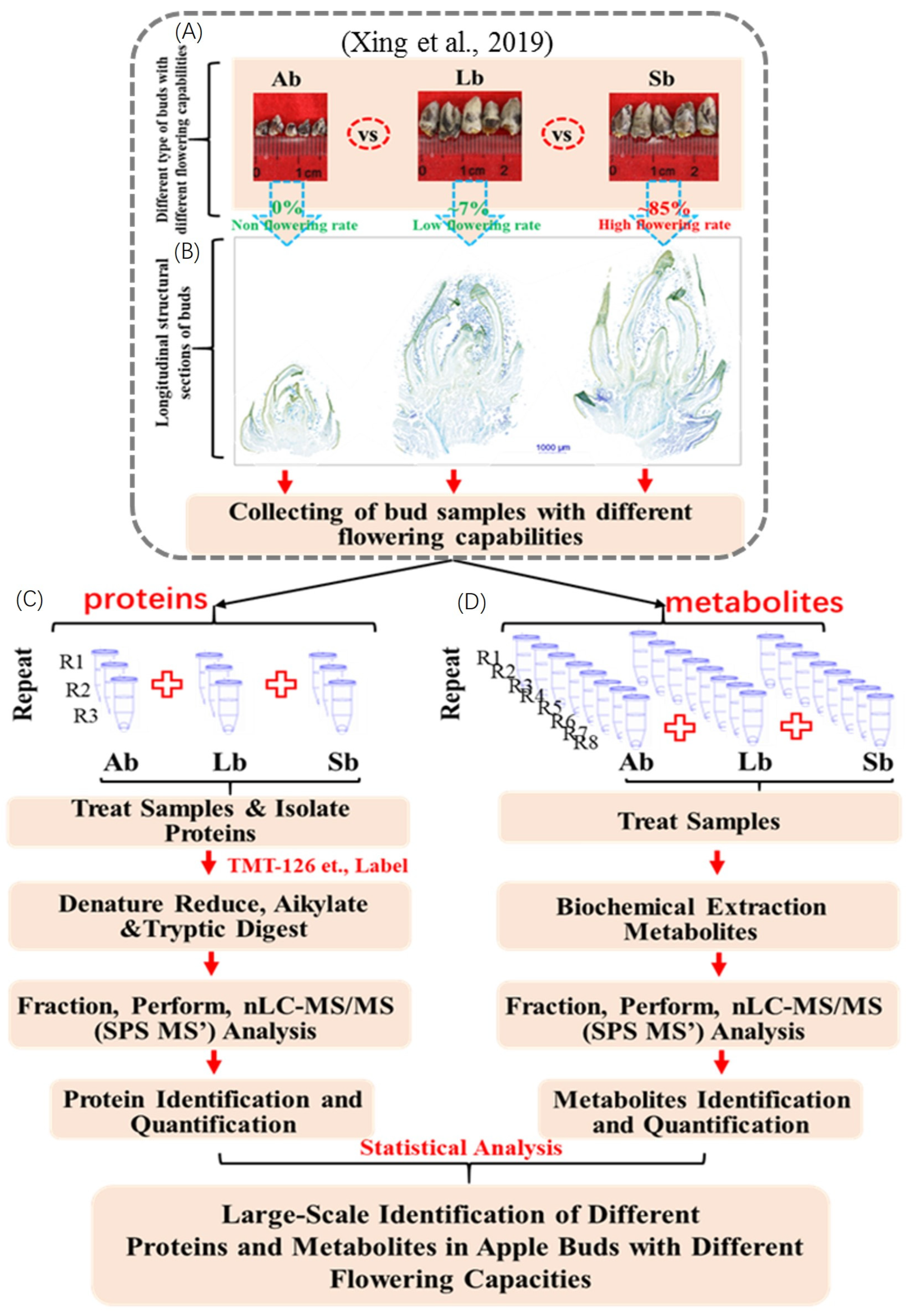
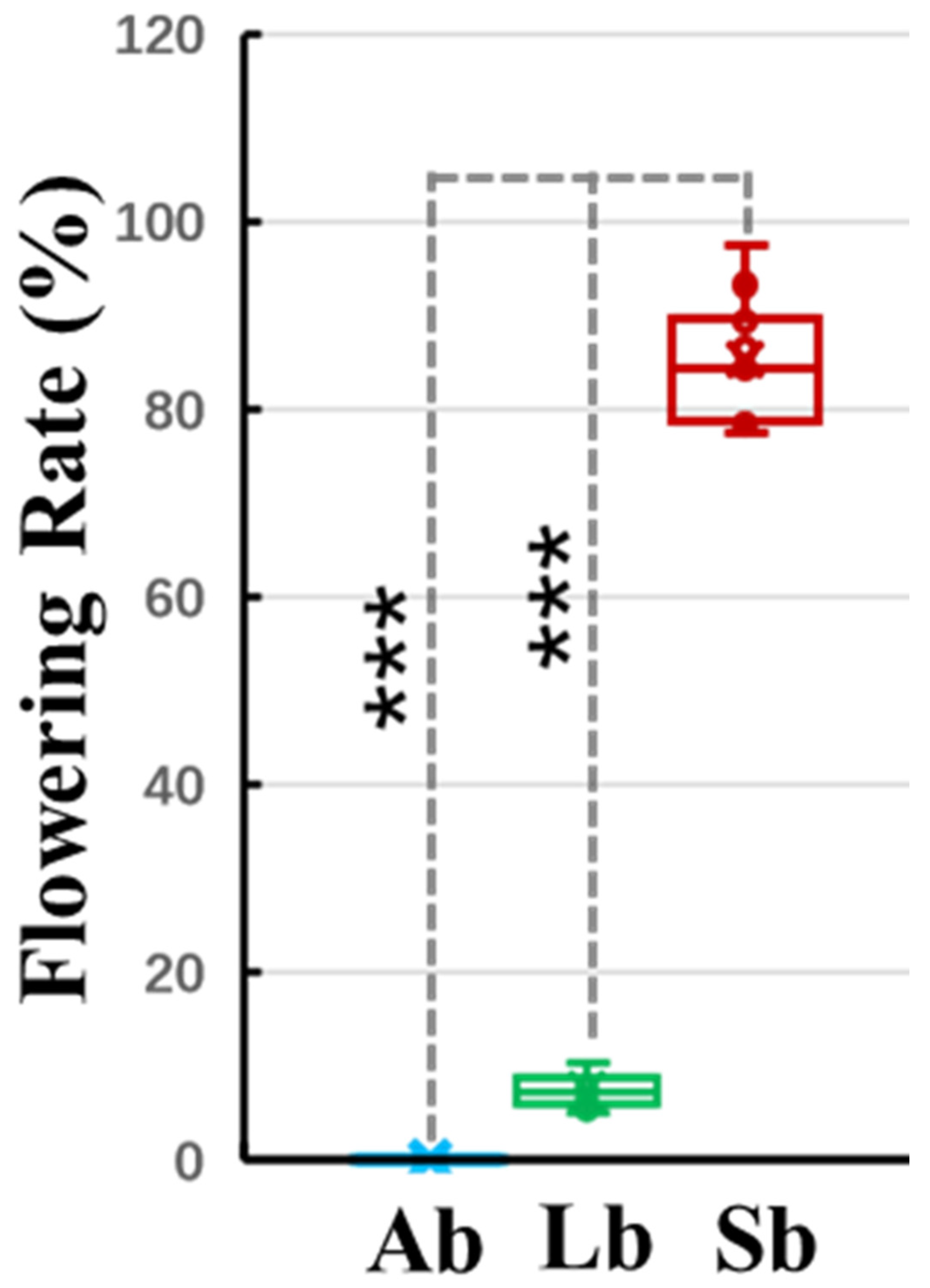
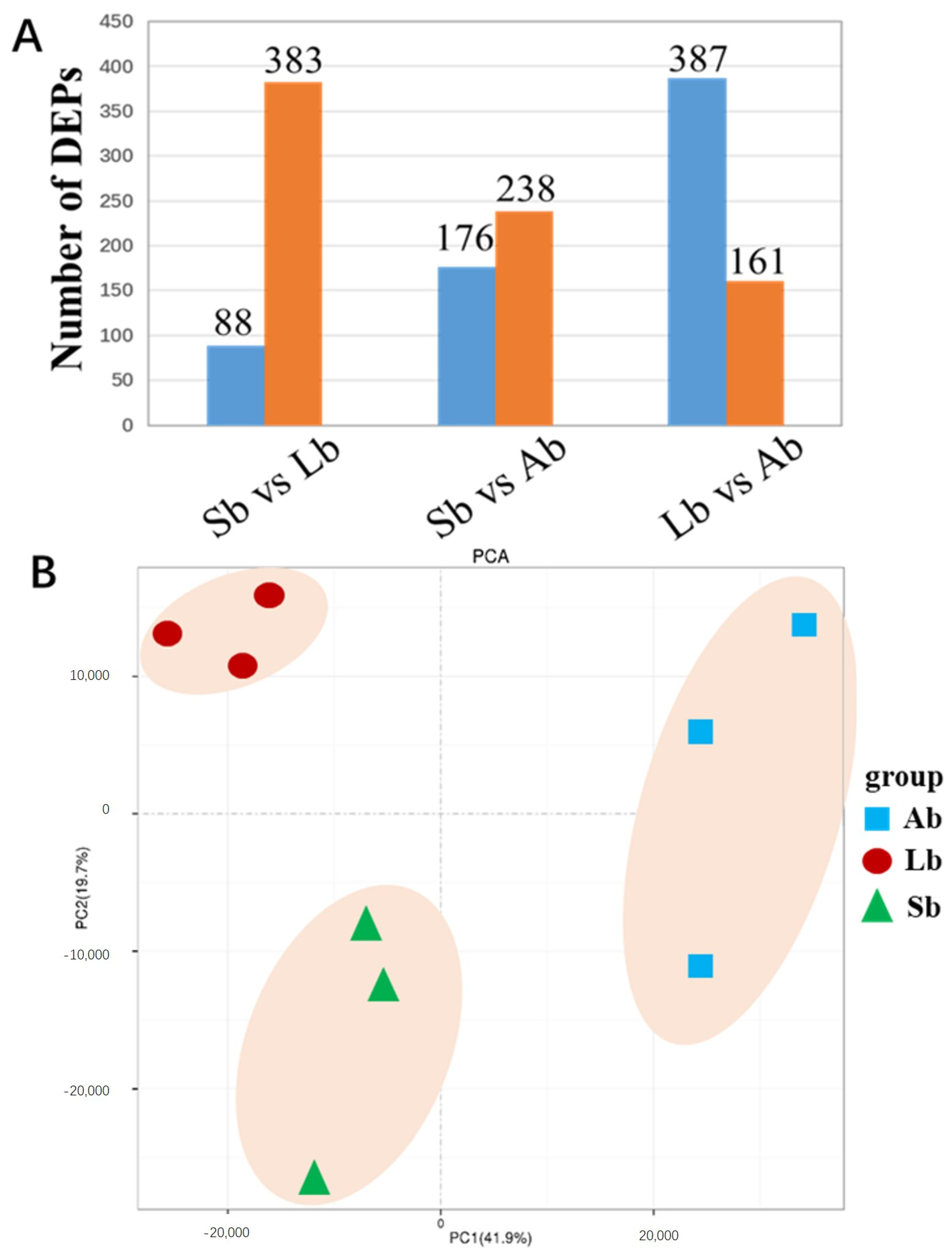
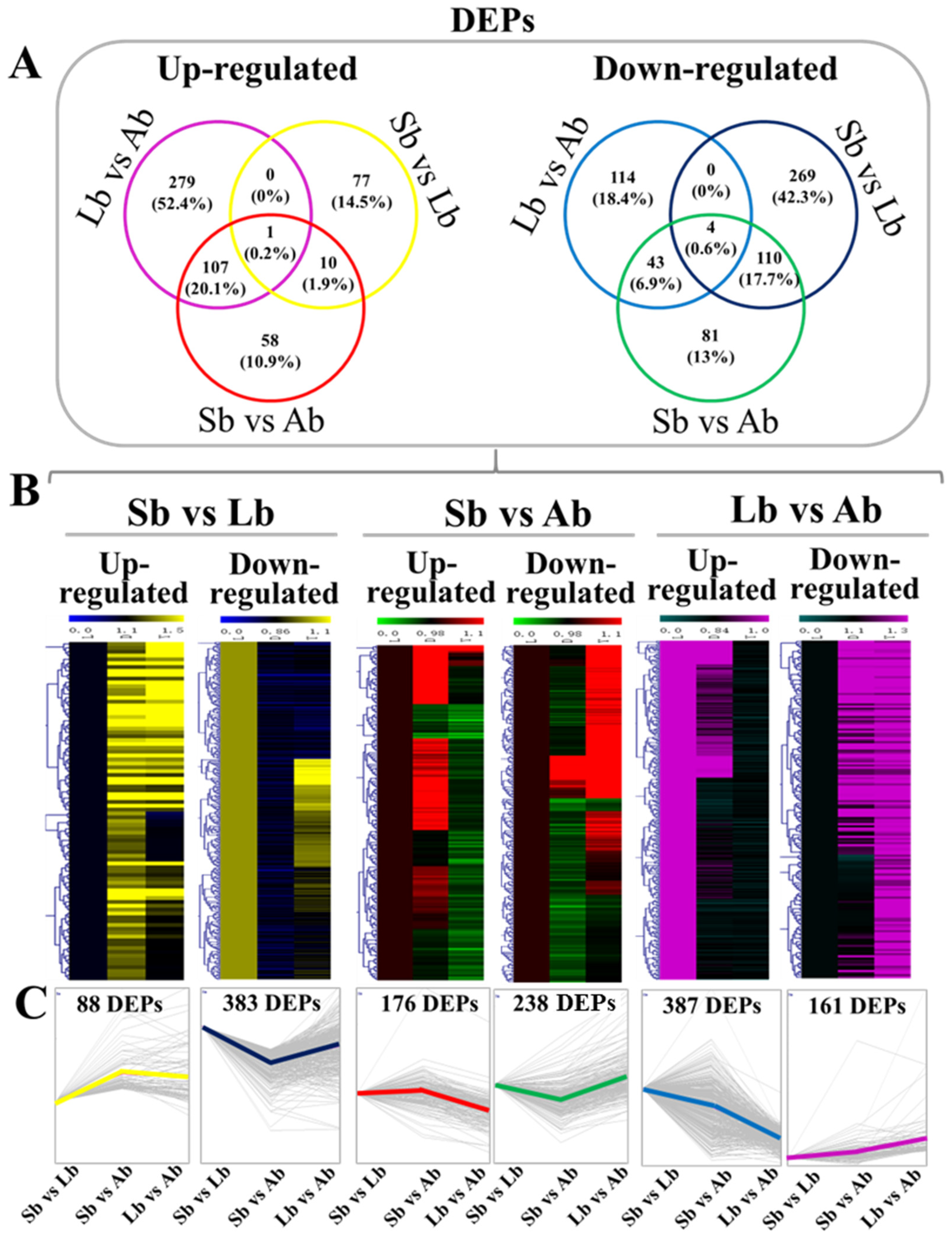
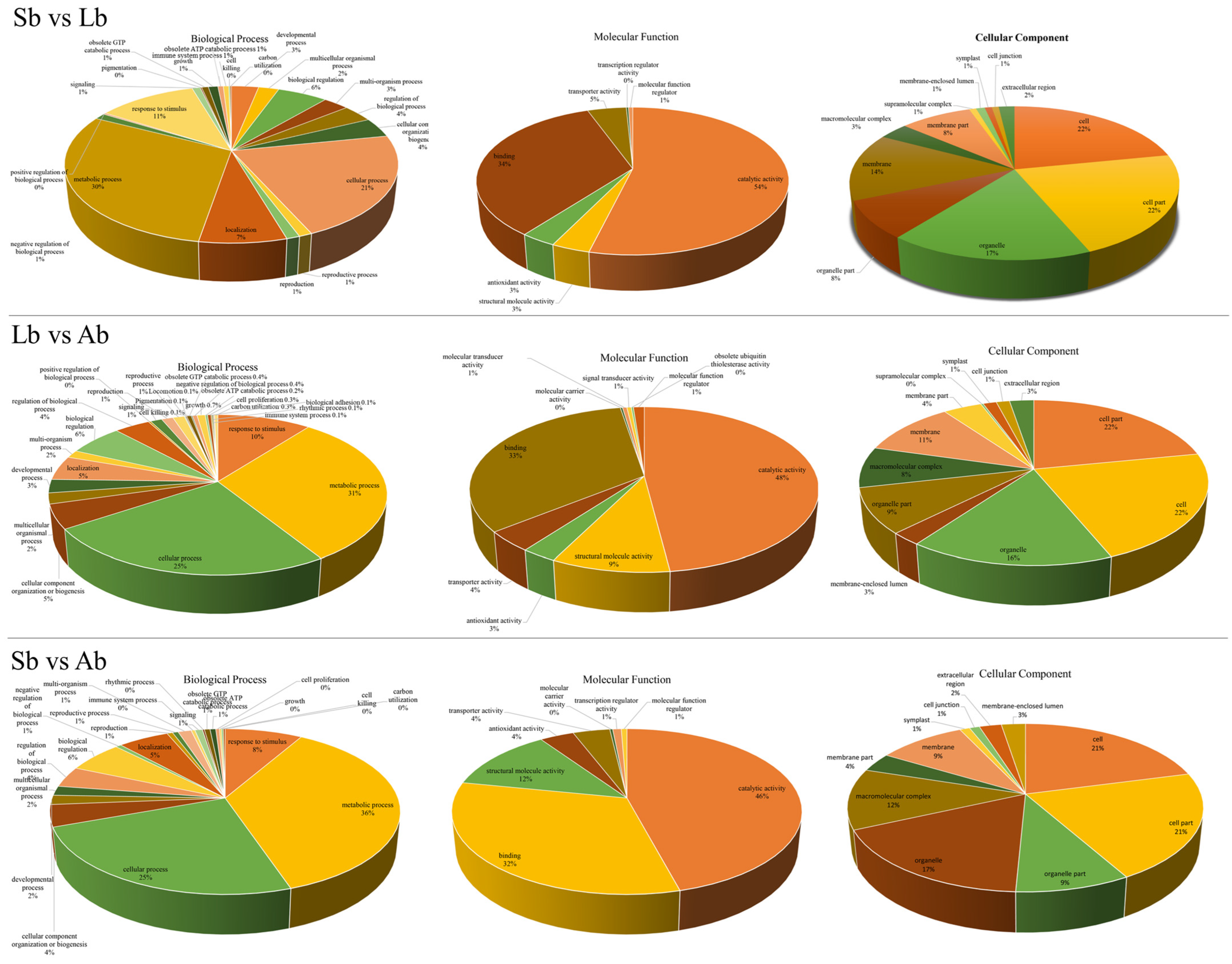
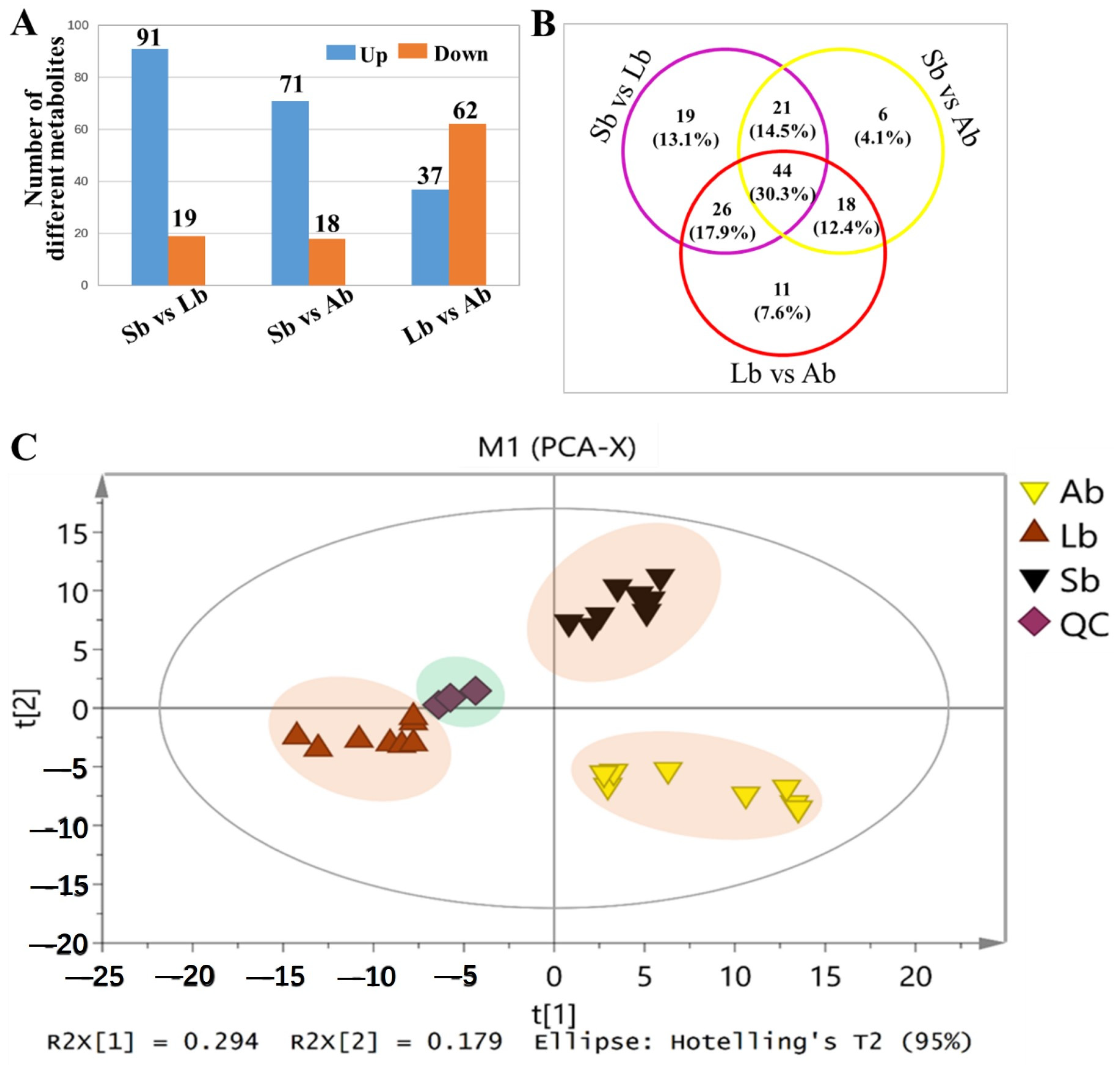
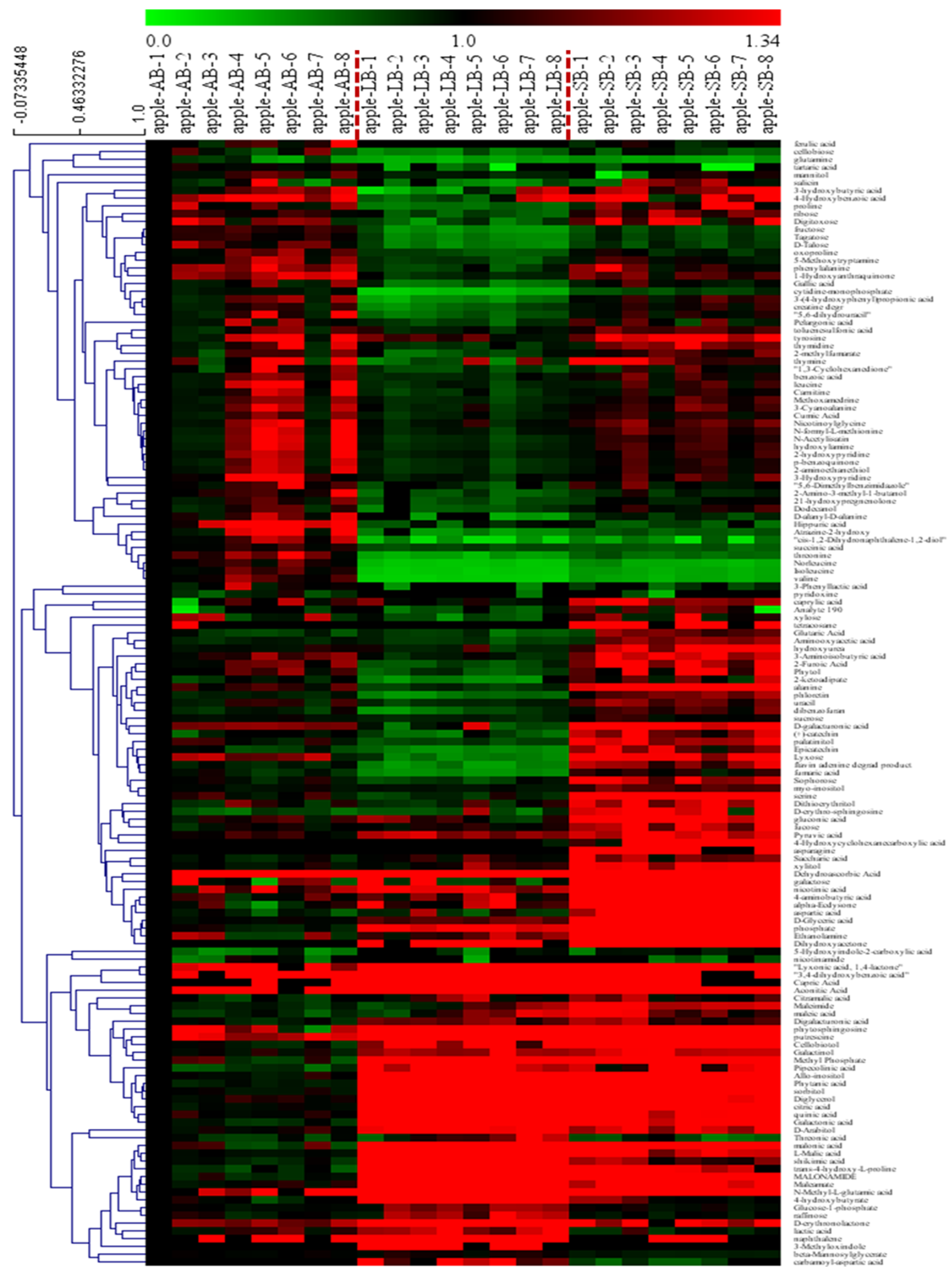

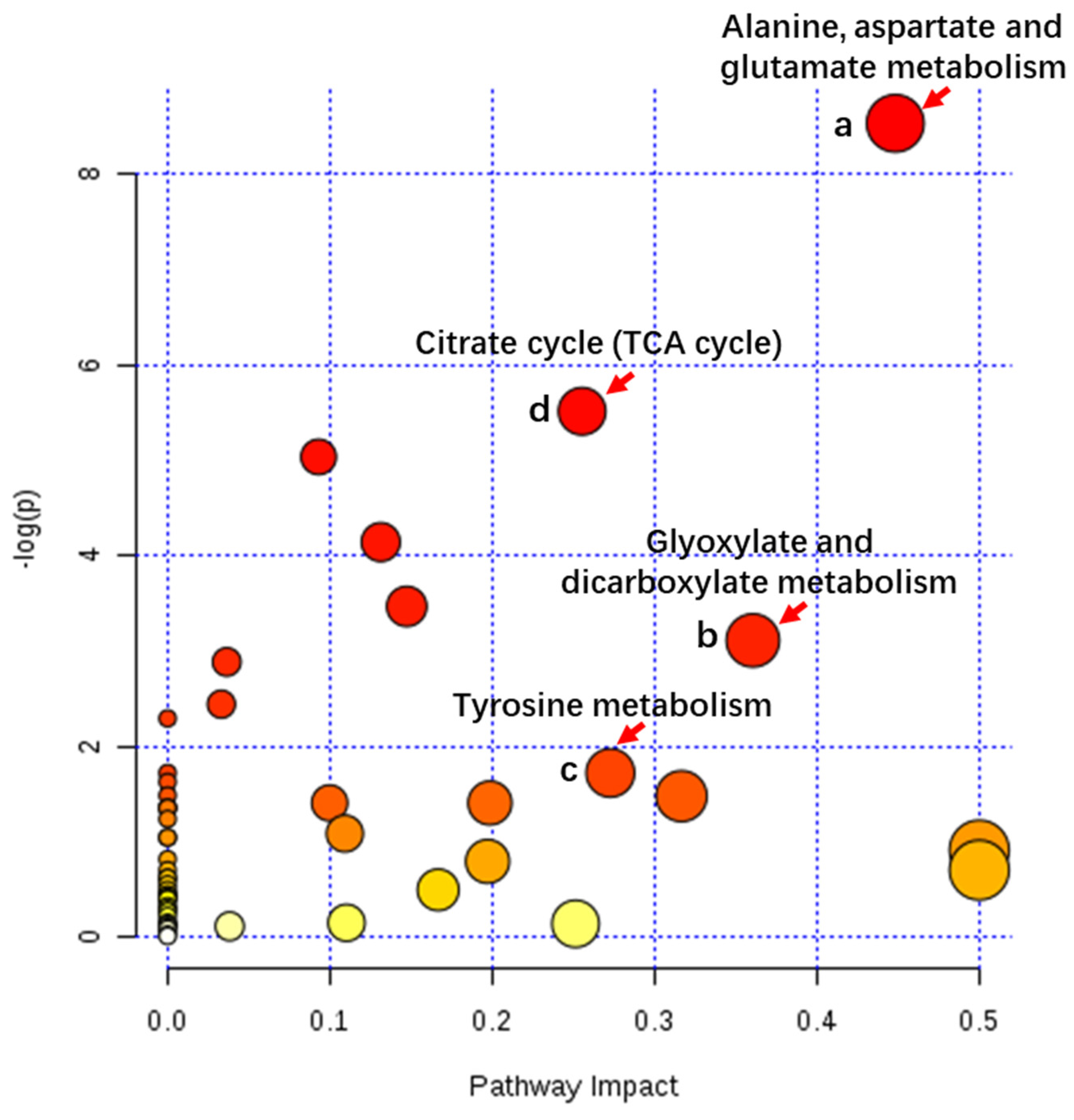
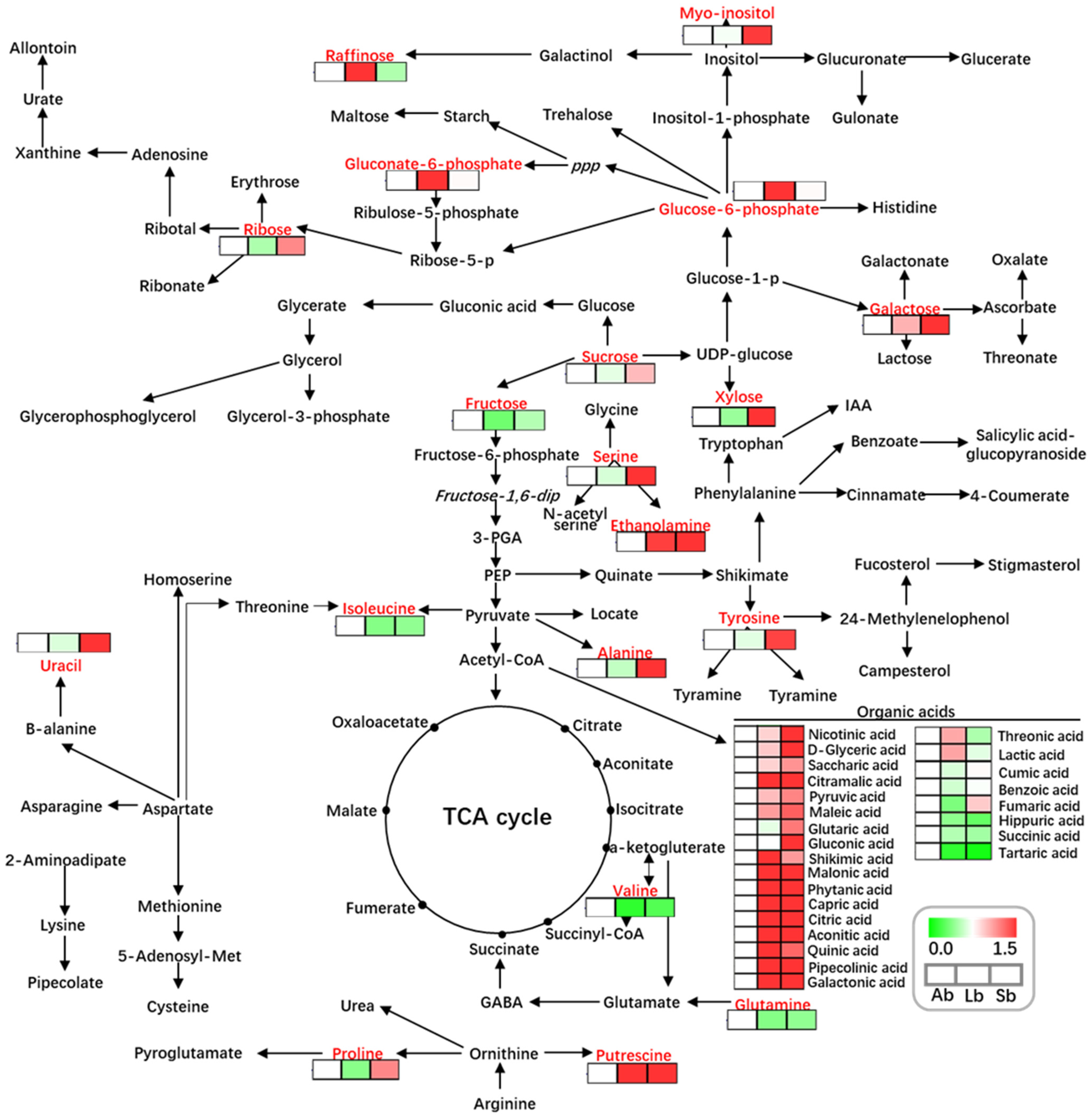
| No. | a Protein ID | Protein Name | Protein Description | Score | b Cov | c Unique Peptides | d MW (kDa) | e Calc. pI | Ratio | ||
|---|---|---|---|---|---|---|---|---|---|---|---|
| Sb/Ab | Sb/Lb | Lb/Ab | |||||||||
| Carbohydrate transport and metabolism | |||||||||||
| 1 | MD10G1063600 | FBA2 | Probable fructose-bisphosphate aldolase 2 | 64.9 | 30.7 | 3 | 42.7 | 7.75 | 1.03 | 1.22 * | 0.84 |
| 3 | MD07G1159300 | GBSSIb | Granule-bound starch synthase 1 | 45.4 | 24.1 | 9 | 67.2 | 7.69 | 0.82 | 1.61 * | 0.51 * |
| 4 | MD07G1226500 | F4C21.14 | Xyloglucan endotransglucosylase/hydrolase protein 9 | 100.6 | 41.3 | 9 | 61.7 | 5.91 | 0.82 | 1.37 * | 0.6 * |
| 5 | MD05G1099400 | BXL5 | Probable beta-D-xylosidase 5 | 76.2 | 22.1 | 14 | 87.1 | 6.87 | 0.82 | 1.31 * | 0.63 * |
| 6 | MD07G1210800 | BXL5 | Probable beta-D-xylosidase 5 | 15.9 | 12.8 | 1 | 17.8 | 7.72 | 0.99 | 1.29 * | 0.76 * |
| 7 | MD02G1049600 | RBCL | Ribulose bisphosphate carboxylase large chain | 35.2 | 16.1 | 6 | 30.2 | 5.31 | 1.15 | 1.28 * | 0.9 |
| 8 | MD06G1148800 | GAPC | Glyceraldehyde-3-phosphate dehydrogenase | 100.4 | 34.5 | 3 | 39.8 | 7.21 | 1.22 * | 1.18 | 1.04 |
| 9 | MD09G1073100 | PGI | Glucose-6-phosphate isomerase | 4.1 | 4 | 2 | 40.7 | 5.67 | 0.82 | 1.14 | 0.72 * |
| 10 | MD12G1028200 | INV1 | Beta-fructofuranosidase, insoluble isoenzyme 1 | 30.7 | 16.3 | 9 | 64.6 | 8.5 | 1.53 * | 1.14 | 1.34 * |
| 11 | MD08G1023600 | PpGAL7 | Beta-galactosidase 3 (Precursor) | 65.7 | 21.5 | 9 | 94.8 | 7.99 | 1.32 * | 1.13 | 1.16 |
| 12 | MD09G1033700 | GAPB | Glyceraldehyde-3-phosphate dehydrogenase GAPB | 40.9 | 26.2 | 3 | 33.8 | 8.18 | 0.9 | 1.13 | 0.8 |
| 13 | MD07G1240700 | BXL4 | Beta-D-xylosidase 4 | 16.8 | 16 | 5 | 36.1 | 5.5 | 0.51 * | 1.11 | 0.46 * |
| 14 | MD06G1002300 | PFKa | Pyrophosphate-fructose 6-phosphate 1-phosphotransferase subunit alpha | 100.2 | 39.4 | 19 | 67.4 | 7.21 | 0.76 * | 1.06 | 0.72 * |
| 15 | MD09G1138500 | HXK2 | Hexokinase-2 | 117.1 | 22.5 | 5 | 154.1 | 4.78 | 1.22 * | 0.94 | 1.29 * |
| 16 | MD02G1021200 | PAP26 | Peroxidase | 31.1 | 21.2 | 7 | 55.8 | 7.78 | 1.34 * | 0.89 | 1.5 * |
| 17 | MD17G1287000 | SUS7 | Sucrose synthase 7 | 20.5 | 6 | 2 | 95.8 | 7.52 | 1.32 * | 0.87 | 1.52 * |
| 18 | MD09G1202200 | SUS6 | Sucrose synthase 6 | 25.8 | 17.9 | 3 | 53.6 | 6.61 | 1.04 | 0.86 | 1.21 * |
| 19 | MD09G1088100 | HXK1 | Hexokinase-1 | 3.5 | 1.2 | 1 | 84.8 | 6.57 | 1.14 | 0.83 | 1.38 * |
| 20 | MD13G1283100 | BGAL9 | Beta-galactosidase 9 | 65 | 17.6 | 14 | 103.5 | 6.04 | 1.09 | 0.82 | 1.33 * |
| 21 | MD09G1214300 | SPS1 | Probable sucrose-phosphate synthase 1 | 20.8 | 7.2 | 5 | 106.2 | 5 | 1.02 | 0.76 * | 1.35 * |
| 22 | MD07G1226000 | GBSSIb | Granule-bound starch synthase 1 | 7.4 | 4.5 | 2 | 67.7 | 7.78 | 0.98 | 0.75 * | 1.3 * |
| 23 | MD09G1192100 | CWINV | Beta-fructofuranosidase, insoluble isoenzyme | 10.2 | 8 | 5 | 64.4 | 8.97 | 0.86 | 0.73 * | 1.17 |
| Amino acid transport and metabolism | |||||||||||
| 24 | MD00G1013000 | MDL2 | (R)-mandelonitrile lyase 2 | 59.1 | 27.5 | 14 | 59.6 | 8.68 | 0.47 * | 0.44 * | 1.06 |
| 25 | MD03G1091100 | MDL3 | (R)-mandelonitrile lyase 3 | 63.5 | 27.6 | 12 | 59.7 | 8.03 | 0.59 * | 0.59 * | 0.99 |
| 26 | MD08G1219100 | At4g24830 | Argininosuccinate synthase | 7.5 | 6.9 | 1 | 53.3 | 5.97 | 1.13 | 0.86 | 1.3 * |
| 27 | MD17G1264900 | ASP1 | Aspartate aminotransferase | 8.1 | 9.5 | 2 | 46.9 | 7.37 | 0.69 * | 0.77 * | 0.9 |
| 28 | MD10G1254300 | CAAT1 | Cationic amino acid transporter 1 | 3.6 | 1.8 | 1 | 66.7 | 7.2 | 0.88 | 0.79 * | 1.11 |
| 29 | MD08G1183900 | EMB1144 | Chorismate synthase | 1.5 | 2.2 | 1 | 35.7 | 7.94 | 1.1 | 0.88 | 1.25 * |
| 30 | MD12G1236000 | OAS | Cysteine synthase | 60.4 | 41 | 1 | 36 | 5.6 | 0.82 | 0.83 | 0.99 |
| 31 | MD08G1207000 | GDH1 | Glutamate dehydrogenase 1 | 73.7 | 30.9 | 15 | 71.9 | 6.99 | 1.11 | 0.84 | 1.32 * |
| 32 | MD01G1174400 | GDH2 | Glutamate dehydrogenase 2 | 18.1 | 10.2 | 1 | 44.6 | 6.76 | 0.92 | 0.82 | 1.13 |
| 33 | MD08G1004100 | AATL1 | Lysine histidine transporter-like 8 | 7.8 | 2.5 | 1 | 62.7 | 7.97 | 0.79 * | 0.75 * | 1.05 |
| 34 | MD15G1141700 | MTHFR2 | Methylenetetrahydrofolate reductase 2 | 88.7 | 39 | 5 | 66.5 | 6.29 | 0.94 | 0.81 | 1.16 |
| 35 | MD08G1184000 | MTHFR2 | Methylenetetrahydrofolate reductase 2 | 19.5 | 17.5 | 1 | 28.8 | 5.29 | 1.28 * | 0.89 | 1.45 * |
| 36 | MD16G1010700 | PTR2 | Peptide transporter | 14.7 | 5.3 | 3 | 64.7 | 6.06 | 0.82 | 0.77 * | 1.06 |
| 37 | MD11G1081200 | PTR5 | Peptide transporter | 3.3 | 1.5 | 1 | 64.7 | 8.6 | 0.86 | 0.78 * | 1.09 |
| 38 | MD07G1172700 | PAL1 | Phenylalanine ammonia-lyase 1 | 63.4 | 22.1 | 8 | 78.5 | 6.61 | 0.88 | 0.71 * | 1.24 * |
| 39 | MD04G1096200 | PAL1 | Phenylalanine ammonia-lyase 1 | 44.1 | 15.4 | 5 | 78.1 | 6.74 | 0.69 * | 0.7 * | 0.99 |
| 40 | MD00G1037100 | DHAPS-1 | Phospho-2-dehydro-3-deoxyheptonate aldolase 1 | 33.9 | 15.1 | 4 | 58.5 | 8.12 | 0.7 * | 0.72 * | 0.98 |
| 41 | MD15G1372600 | DHAPS-1 | Phospho-2-dehydro-3-deoxyheptonate aldolase 1 | 55.7 | 22.3 | 1 | 59.4 | 8.48 | 0.83 | 0.8 | 1.04 |
| 42 | MD08G1186700 | DHAPS-1 | Phospho-2-dehydro-3-deoxyheptonate aldolase 1 | 53 | 24.1 | 3 | 59.6 | 8.34 | 0.9 | 0.81 | 1.11 |
| 43 | MD06G1186500 | At5g62680 | Probable peptide/nitrate transporter | 9.1 | 6.5 | 2 | 48 | 8.84 | 0.77 * | 0.84 | 0.91 |
| 44 | MD05G1102900 | SCPL18 | Serine carboxypeptidase-like 18 | 27.2 | 18.2 | 4 | 51.8 | 5.38 | 0.89 | 0.73 * | 1.22 |
| 45 | MD07G1207000 | SCPL50 | Serine carboxypeptidase-like 50 | 15.4 | 5.9 | 4 | 75.8 | 7.2 | 1.13 | 0.8 | 1.4 * |
| 46 | MD16G1027500 | SCPL50 | Serine carboxypeptidase-like 50 | 24.7 | 11.2 | 2 | 49.4 | 8.94 | 0.64 * | 0.43 * | 1.52 * |
| Lipid transport and metabolism | |||||||||||
| 47 | MD13G1208400 | MENB | 1,4-Dihydroxy-2-naphthoyl-CoA synthase | 4 | 14.5 | 1 | 8.2 | 5.4 | 1.03 | 0.46 * | 2.25 * |
| 48 | MD02G1229900 | CHY1 | 3-hydroxyisobutyryl-CoA hydrolase 1 | 17.5 | 13.2 | 1 | 27.1 | 6.05 | 0.85 | 0.77 * | 1.11 |
| 49 | MD17G1229400 | 4CL1 | 4-coumarate-CoA ligase 1 | 28.6 | 11.5 | 5 | 59.5 | 5.9 | 0.92 | 0.76* | 1.2 * |
| 50 | MD13G1161400 | 4CL1 | 4-coumarate-CoA ligase 1 | 109.6 | 79.9 | 5 | 17.6 | 6.02 | 0.98 | 1.19 | 0.82 |
| 51 | MD06G1147500 | 4CLL9 | 4-coumarate-CoA ligase-like 9 | 12.3 | 7.7 | 1 | 60.6 | 7.43 | 0.99 | 0.8 | 1.24 * |
| 52 | MD12G1159600 | CAC3 | Acetyl-coenzyme A carboxylase carboxyl transferase subunit alpha | 102.4 | 36 | 11 | 84.7 | 8.87 | 0.79 * | 1.05 | 0.75 * |
| 53 | MD08G1051100 | CAC3 | Acetyl-coenzyme A carboxylase carboxyl transferase subunit alpha | 11.5 | 4.2 | 2 | 53 | 8.34 | 0.86 | 0.7 * | 1.23 * |
| 54 | MD09G1168200 | OSCBPY | Beta-amyrin synthase | 20.3 | 12.3 | 1 | 87.6 | 6.93 | 0.93 | 0.83 | 1.12 |
| 55 | MD17G1159500 | OSCBPY | Beta-amyrin synthase | 24.4 | 13.3 | 2 | 87.3 | 6.61 | 0.78 * | 1.05 | 0.74 * |
| 56 | MD13G1274100 | OSCBPY | Beta-amyrin synthase | 4.8 | 31.2 | 2 | 9.1 | 5.88 | 1.02 | 0.81 | 1.27 * |
| 57 | MD17G1057500 | BCCP2 | Biotin carboxyl carrier protein of acetyl-CoA carboxylase 2 | 13.7 | 6.4 | 1 | 29.7 | 6.89 | 0.77 * | 0.83 | 0.92 |
| 59 | MD13G1221200 | CASBPX2 | Cycloartenol synthase 2 | 7.6 | 11 | 1 | 10.9 | 9.7 | 0.7 * | 0.94 | 0.74 * |
| 60 | MD13G1153100 | PATL3 | Patellin-3 | 30.2 | 16.8 | 4 | 29.7 | 10.36 | 1.26 * | 0.72 * | 1.74 |
| 61 | MD10G1282800 | DSEL | Phospholipase A1-IIgamma | 37.9 | 24 | 8 | 48.6 | 8.91 | 0.79 * | 1.26 * | 0.63 * |
| 62 | MD13G1145600 | DSEL | Phospholipase A1-IIgamma | 4 | 3.9 | 1 | 35.3 | 7.25 | 2.71 * | 0.74 * | 3.67 * |
| 63 | MD10G1119700 | CXE2 | Probable carboxylesterase 2 | 49.8 | 61.9 | 6 | 10.9 | 7.24 | 0.81 | 1.18 | 0.69 * |
| 64 | MD10G1091100 | CXE7 | Probable carboxylesterase 7 | 39 | 27.7 | 8 | 33.4 | 5.76 | 1.23 * | 0.95 | 1.3 * |
| 65 | MD10G1142100 | CXE7 | Probable carboxylesterase 7 | 9.9 | 5.3 | 2 | 78.2 | 5.16 | 1.08 | 0.8 | 1.35 * |
| 66 | MD16G1073700 | SBH2 | Sphinganine C (4)-monooxygenase 2 | 5.2 | 6.6 | 1 | 29.5 | 7.78 | 0.85 | 0.77 * | 1.09 |
| No. | Peak | Mass | RT (min) | Ratio | ||
|---|---|---|---|---|---|---|
| Sb/Ab | Sb/Lb | Lb/Ab | ||||
| Amino acids and their isoforms | ||||||
| 1 | Alanine | 116 | 11.05 | 1.37 * | 1.79 * | 0.76 * |
| 2 | Proline | 142 | 14.57 | 1.09 | 2.02 * | 0.54 * |
| 3 | Threonine | 202 | 16.03 | 0.52 * | 1.75 * | 0.3 * |
| 4 | Phenylalanine | 120 | 18.67 | 0.92 | 1.39 * | 0.66 * |
| 5 | Lyxose | 160 | 20.36 | 1.23 * | 2.55 * | 0.48 * |
| 6 | Tyrosine | 100 | 21.85 | 1.14 | 1.28 * | 0.89 |
| 7 | Oxoproline | 156 | 18.26 | 0.86 | 1.3 * | 0.66 * |
| 8 | Isoleucine | 158 | 14.45 | 0.34 * | 1.64 * | 0.21 * |
| 9 | Serine | 204 | 15.56 | 1.71 * | 2.02 * | 0.84 |
| 10 | Aspartic acid | 232 | 18.13 | 1.95 * | 1.9 * | 1.03 |
| 11 | Valine | 144 | 13.09 | 0.32 * | 1.74 * | 0.19 * |
| 12 | N-formyl-L-methionine | 175 | 9.33 | 0.97 | 1.2 * | 0.8 |
| 13 | N-Acetylisatin | 146 | 10.36 | 0.92 | 1.25 * | 0.74 * |
| 14 | Maleimide | 154 | 10.86 | 1.52 * | 1.37 * | 1.11 |
| 15 | Hydroxylamine | 146 | 11.16 | 0.95 | 1.24 * | 0.77 * |
| 16 | Malonamide | 172 | 18.79 | 1.79 * | 0.27 * | 6.58 * |
| 17 | Putrescine | 174 | 21.4 | 1.54 * | 1.13 | 1.36 * |
| 18 | N-Methyl-L-glutamic acid | 98 | 13.9 | 1.94 * | 0.49 * | 3.94 * |
| 19 | Trans-4-hydroxy-L-proline | 158 | 17.38 | 2.06 * | 0.44 * | 4.68 * |
| 20 | Nicotinoylglycine | 208 | 9.91 | 0.98 | 1.18 | 0.83 |
| 21 | D-alanyl-D-alanine | 188 | 15.66 | 0.75 * | 4.8 * | 0.16 * |
| 22 | Nicotinamide | 179 | 24.04 | 0.53 * | 8 * | 0.07 * |
| 23 | Glutamine | 155 | 11.89 | 0.57 * | 1.09 | 0.52 * |
| 24 | Leucine | 158 | 9.6 | 0.95 | 1.18 | 0.8 |
| Sugars and polyols | ||||||
| 25 | Sucrose | 243 | 31.8 | 1.05 | 1.21 * | 0.9 |
| 26 | Fructose | 103 | 23.29 | 0.71 * | 1.61 * | 0.44 * |
| 27 | Tagatose | 103 | 23.41 | 0.75 * | 1.49 * | 0.5 * |
| 28 | Fucose | 117 | 9.27 | 1.78 * | 1.26 * | 1.41 * |
| 29 | Xylose | 160 | 20.27 | 1.29 * | 2.12 * | 0.61 * |
| 30 | Cellobiose | 231 | 30.75 | 0.86 | 1.44 * | 0.6 * |
| 31 | Sophorose | 204 | 34.87 | 1.33 * | 1.62 * | 0.82 |
| 32 | Galactose | 186 | 28.12 | 2 * | 2 * | 1 |
| 33 | D-Talose | 160 | 23.64 | 0.71 * | 1.49 * | 0.48 * |
| 34 | Phytol | 143 | 9.35 | 1.19 | 1.77 * | 0.67 * |
| 35 | Palatinitol | 204 | 34.29 | 1.32 * | 1.76 * | 0.75 * |
| 36 | Cis-1,2-Dihydronaphthalene-1,2-diol | 191 | 17.07 | 0.38 * | 1.49 * | 0.25 * |
| 37 | 2-Amino-3-methyl-1-butanol | 188 | 11.04 | 0.91 | 1.54 * | 0.59 * |
| 38 | Dodecanol | 243 | 17.02 | 1.03 | 1.74 * | 0.59 * |
| 39 | 2-aminoethanethiol | 174 | 10.24 | 0.93 | 1.22 * | 0.76 * |
| 40 | Pyridoxine | 281 | 20.65 | 0.2 * | 2 * | 0.1 * |
| 41 | D-erythro-sphingosine | 204 | 22.1 | 1.92 * | 1.82 * | 1.06 |
| 42 | Xylitol | 129 | 21.02 | 1.96 * | 1.34 * | 1.46 * |
| 43 | D-Arabitol | 243 | 21.05 | 1.31 * | 0.81 | 1.62 * |
| 44 | Allo-inositol | 191 | 25.25 | 1.59 * | 0.93 | 1.71 * |
| 45 | Galactinol | 204 | 23.65 | 1.33 * | 1.06 | 1.25 * |
| 46 | Sorbitol | 231 | 21.9 | 1.91 * | 0.79 * | 2.42 * |
| 47 | Raffinose | 306 | 22.38 | 0.69 * | 0.49 * | 1.41 * |
| 48 | Myo-inositol | 217 | 26 | 1.14 | 1.19 | 0.96 |
| 49 | Mannitol | 74 | 24.2 | 0.81 | 0.94 | 0.86 |
| Organic acids | ||||||
| 50 | Pyruvic acid | 174 | 10.11 | 1.3 * | 1.12 | 1.16 |
| 51 | Pipecolinic acid | 156 | 13.16 | 1.56 * | 0.9 | 1.72 * |
| 52 | Aconitic Acid | 215 | 21.35 | 1.58 * | 0.88 | 1.79 * |
| 53 | Galactonic acid | 275 | 23.38 | 1.66 * | 0.9 | 1.83 * |
| 54 | Quinic acid | 215 | 23.14 | 1.38 * | 0.91 | 1.51 * |
| 55 | Citramalic acid | 231 | 17.47 | 2.06 * | 1.17 | 1.76 * |
| 56 | Maleic acid | 126 | 14.6 | 1.39 * | 1.12 | 1.24 * |
| 57 | Gluconic acid | 299 | 21.7 | 1.58 * | 1.58 * | 1 |
| 58 | Nicotinic acid | 106 | 14.52 | 1.53 * | 1.38 * | 1.11 |
| 59 | Benzoic acid | 179 | 13.69 | 0.98 | 1.2 * | 0.82 |
| 60 | D-Glyceric acid | 189 | 15.06 | 1.56 * | 1.37 * | 1.14 |
| 61 | Glutaric Acid | 192 | 18.93 | 1.33 * | 1.47 * | 0.9 |
| 62 | Citric acid | 183 | 22.49 | 1.56 * | 1.02 | 1.52 * |
| 63 | Phytanic acid | 159 | 24.42 | 1.71 * | 0.74 * | 2.3 * |
| 64 | Malonic acid | 305 | 18.22 | 1.7 * | 0.66 * | 2.57 * |
| 65 | Shikimic acid | 204 | 21.13 | 1.25 * | 0.7 * | 1.79 * |
| 66 | Capric Acid | 117 | 17.04 | 2.45 * | 0.66 * | 3.73 * |
| 67 | Saccharic acid | 333 | 25.19 | 1.27 * | 1.14 | 1.11 |
| 68 | Cumic Acid | 222 | 9.95 | 1.01 | 1.18 | 0.85 |
| 69 | Fumaric acid | 245 | 17.49 | 1.13 | 2.3 * | 0.49 * |
| 70 | Succinic acid | 147 | 14.7 | 0.64 * | 0.91 | 0.7 * |
| 71 | Hippuric acid | 208 | 9.56 | 0.39 * | 0.7 * | 0.56 * |
| 72 | Tartaric acid | 204 | 25.26 | 0.09 * | 0.44 * | 0.2 * |
| 73 | Threonic acid | 220 | 18.56 | 0.68 * | 0.56 * | 1.21 * |
| 74 | Lactic acid | 117 | 10.3 | 0.89 | 0.73 * | 1.22 * |
Disclaimer/Publisher’s Note: The statements, opinions and data contained in all publications are solely those of the individual author(s) and contributor(s) and not of MDPI and/or the editor(s). MDPI and/or the editor(s) disclaim responsibility for any injury to people or property resulting from any ideas, methods, instructions or products referred to in the content. |
© 2023 by the authors. Licensee MDPI, Basel, Switzerland. This article is an open access article distributed under the terms and conditions of the Creative Commons Attribution (CC BY) license (https://creativecommons.org/licenses/by/4.0/).
Share and Cite
Wang, S.; Chen, X.; Liu, S.; Zhang, X.; Li, Y.; Shang, W.; Song, J.; Tian, J.; Li, X.; Xing, L. Comparative Proteomic and Metabonomic Profiling of Buds with Different Flowering Capabilities Reveal Novel Regulatory Mechanisms of Flowering in Apple. Plants 2023, 12, 3959. https://doi.org/10.3390/plants12233959
Wang S, Chen X, Liu S, Zhang X, Li Y, Shang W, Song J, Tian J, Li X, Xing L. Comparative Proteomic and Metabonomic Profiling of Buds with Different Flowering Capabilities Reveal Novel Regulatory Mechanisms of Flowering in Apple. Plants. 2023; 12(23):3959. https://doi.org/10.3390/plants12233959
Chicago/Turabian StyleWang, Shujin, Xiaoping Chen, Sitong Liu, Xiaochen Zhang, Yu Li, Wei Shang, Jiahui Song, Jianwen Tian, Xiaolong Li, and Libo Xing. 2023. "Comparative Proteomic and Metabonomic Profiling of Buds with Different Flowering Capabilities Reveal Novel Regulatory Mechanisms of Flowering in Apple" Plants 12, no. 23: 3959. https://doi.org/10.3390/plants12233959
APA StyleWang, S., Chen, X., Liu, S., Zhang, X., Li, Y., Shang, W., Song, J., Tian, J., Li, X., & Xing, L. (2023). Comparative Proteomic and Metabonomic Profiling of Buds with Different Flowering Capabilities Reveal Novel Regulatory Mechanisms of Flowering in Apple. Plants, 12(23), 3959. https://doi.org/10.3390/plants12233959





